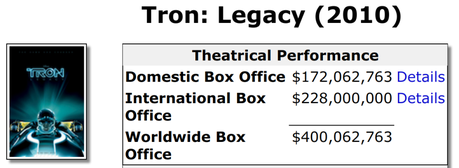Blade Runner: 2049 is the long-awaited sequel to a sci-fi cult classic that was a box office failure when it came out in 1982, but we've heard this one before. This same exact scenario played out in 2010 when Disney dropped $170 million on Tron Legacy, clearly gambling that a big budget update of an old Jeff Bridges property mostly known for its at-the-time groundbreaking, but now rather dated special effects would be worth it, especially if they filmed it almost entirely in 3D and hired Daft Punk to do the soundtrack. Disney even added -themed attractions to its various theme parks and made pre-emptive plans to launch a new Tron trilogy after , assuming, of course, Legacy didn't turn out to be a lemon.
Yeah. About that.

Actually, for a movie with a $170m budget (and who knows how much on marketing) that's not exactly a terrible total, but it's not the surefire franchise re-starter Disney was looking for, which is why Tron 3 never happened and at last check has morphed into vague talk of a complete franchise reboot starring Jared Leto.
Speaking of Jared Leto, Blade Runner: 2049, the official word is Alcon Entertainment, WB and Sony spent $150m on this near masterpiece of a sequel, but industry speculation pegs the true total as being closer to $200m. Just like Tron: Legacy, it's a really big bet that a cult classic beloved by fanboys and fangirls could have real blockbuster potential. Remember, with just $27m in domestic box office (off of a $28m budget) the original Blade Runner is one of the lowest grossing films of Harrison Ford's career, and according to Forbes in order to break even 2049 will have to become one of the highest grossing non- Star Wars/ Indiana Jones Ford movies.
Of Harrison Ford's ten biggest grossers, eight of them are (understandably) Star Wars and Indiana Jones movies. The two exceptions are The Fugitive ($183 million domestic and $368m worldwide in 1993) and Air Force One ($171m/$294m in 1997). Beyond that, again not taking into account inflation and overseas expansion, it's all movies that were big hits despite earning less than $300m worldwide. That's the thing with old-school movie stars. The likes of Tom Hanks, Tom Cruise, Harrison Ford and Julia Roberts did their thing back when a $15m debut, $75-$100m domestic gross and $200-$250m worldwide total was usually more than good enough on a $20-$60m budget.
We saw something similar play out in 2014, when Tom Cruise's well-received Edge of Tomorrow earned $102 million domestic and $367m worldwide, good for Cruise's third-biggest non- Mission: Impossible grosser but not good enough on a $175m budget. Everyone is throwing around Mad Max: Fury Road as a positive comparison, but that film earned a terrific $155m domestic but a less terrific $376m worldwide on a $150m budget.
And literally as I'm writing this the early returns on 2049 's opening weekend have come in, and they're not good, coming in around $10m-$15m below expectations with a projected domestic debut in the $30m-$35m range. It's also opening just about everywhere else in the world other than China, Japan and South Korea, and it'll now need to do better over there than here.

